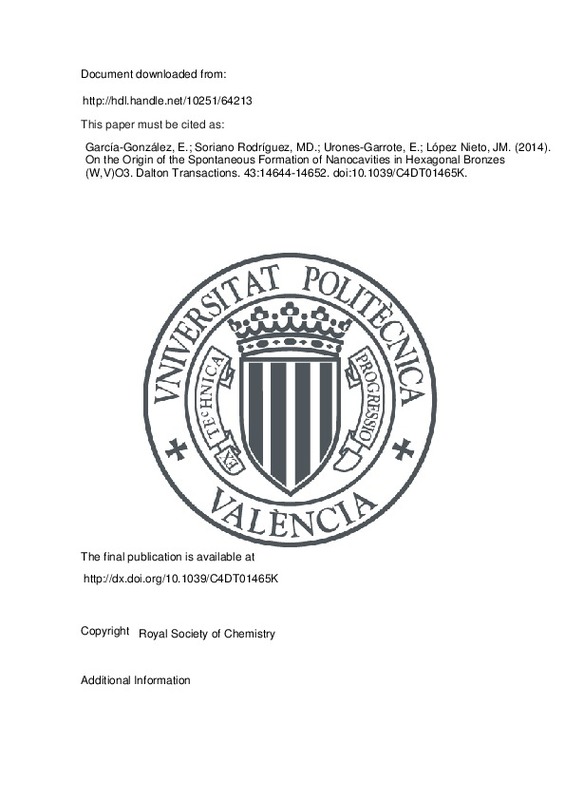JavaScript is disabled for your browser. Some features of this site may not work without it.
Buscar en RiuNet
Listar
Mi cuenta
Estadísticas
Ayuda RiuNet
Admin. UPV
On the Origin of the Spontaneous Formation of Nanocavities in Hexagonal Bronzes (W,V)O3
Mostrar el registro sencillo del ítem
Ficheros en el ítem
| dc.contributor.author | García-González, E.
|
es_ES |
| dc.contributor.author | Soriano Rodríguez, Mª Dolores
|
es_ES |
| dc.contributor.author | Urones-Garrote, E
|
es_ES |
| dc.contributor.author | López Nieto, José Manuel
|
es_ES |
| dc.date.accessioned | 2016-05-17T09:27:54Z | |
| dc.date.available | 2016-05-17T09:27:54Z | |
| dc.date.issued | 2014 | |
| dc.identifier.issn | 1477-9226 | |
| dc.identifier.uri | http://hdl.handle.net/10251/64213 | |
| dc.description.abstract | [EN] Hexagonal (W,V)O3−x oxides of high thermal stability have been synthesized hydrothermally through the intermediate products Nax(W,V)O3·zH2O and (NH4)0.33−x(W,V)O3−y. The obtained crystals show nanostructured surface via the formation of a dense population of polyhedral nanocavities self-distributed along particular crystallographic directions. Nanocavities present a regular size that ranges from 5 to 10 nm in both length and width. The synthesis process involves a significant topotactic relationship between the as-synthesized product and the desired final product and this relationship is suggested as the origin of the observed surface nanostructure. The comparison of our results with observations in different solids has allowed us to suggest that the formation of nanocavities is an extensive spontaneous process when materials are obtained by the chemical reactions of solids leading to products with defined crystallographic orientation with respect to the original compound. The characterization provides evidence regarding the potential relevance of nanocavities in the functional properties of the resulting solids. | es_ES |
| dc.description.sponsorship | Authors acknowledge the financial support from DGICYT in Spain through projects MAT2010-19837-C06-05 and CTQ2012-37925-C03-1. Authors are also grateful to the Centro de Microscopia Electronica (UCM) for facilities. | |
| dc.language | Inglés | es_ES |
| dc.publisher | Royal Society of Chemistry | es_ES |
| dc.relation.ispartof | Dalton Transactions | es_ES |
| dc.rights | Reserva de todos los derechos | es_ES |
| dc.subject | Spontaneous Formation of Nanocavities | es_ES |
| dc.subject | HTB tungsten bronze | es_ES |
| dc.subject | Vanadium-containing hexagonal Bronzes | es_ES |
| dc.subject | (W,V)O3 | es_ES |
| dc.subject | h-WO3 | es_ES |
| dc.subject | polyhedral nanocavities | es_ES |
| dc.subject | HAADF-STEM | es_ES |
| dc.subject | H2S partial oxidation catalyst | es_ES |
| dc.title | On the Origin of the Spontaneous Formation of Nanocavities in Hexagonal Bronzes (W,V)O3 | es_ES |
| dc.type | Artículo | es_ES |
| dc.identifier.doi | 10.1039/C4DT01465K | |
| dc.relation.projectID | info:eu-repo/grantAgreement/MICINN//MAT2010-19837-C06-05/ES/SINTESIS, CARACTERIZACION Y PROCESADO DE MATERIALES PARA BATERIAS Y PILAS DE COMBUSTIBLE/ | es_ES |
| dc.relation.projectID | info:eu-repo/grantAgreement/MINECO//CTQ2012-37925-C03-01/ES/CATALIZADORES PARA LA ENERGIA Y EL MEDIOAMBIENTE: ACTIVACION SELECTIVA DE ENLACES S-H Y C-H/ | es_ES |
| dc.rights.accessRights | Abierto | es_ES |
| dc.contributor.affiliation | Universitat Politècnica de València. Instituto Universitario Mixto de Tecnología Química - Institut Universitari Mixt de Tecnologia Química | es_ES |
| dc.description.bibliographicCitation | García-González, E.; Soriano Rodríguez, MD.; Urones-Garrote, E.; López Nieto, JM. (2014). On the Origin of the Spontaneous Formation of Nanocavities in Hexagonal Bronzes (W,V)O3. Dalton Transactions. 43:14644-14652. https://doi.org/10.1039/C4DT01465K | es_ES |
| dc.description.accrualMethod | S | es_ES |
| dc.relation.publisherversion | http://dx.doi.org/10.1039/C4DT01465K | es_ES |
| dc.description.upvformatpinicio | 14644 | es_ES |
| dc.description.upvformatpfin | 14652 | es_ES |
| dc.type.version | info:eu-repo/semantics/publishedVersion | es_ES |
| dc.description.volume | 43 | es_ES |
| dc.relation.senia | 289558 | es_ES |
| dc.identifier.pmid | 25142181 | |
| dc.contributor.funder | Ministerio de Ciencia e Innovación | |
| dc.contributor.funder | Ministerio de Economía y Competitividad | es_ES |







![[Cerrado]](/themes/UPV/images/candado.png)

